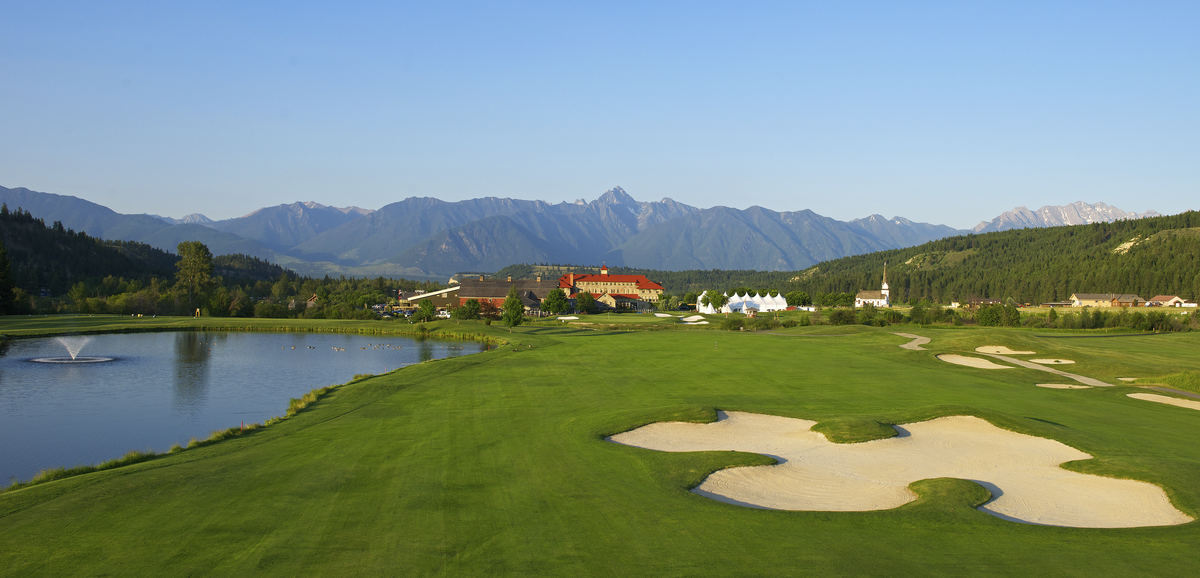St. Eugene golf course in Cranbrook, B.C., goes above and beyond as a destination

CRANBROOK, British Columbia – St. Eugene meets all the requirements of a destination golf course. And then some.
The course is challenging but playable as the layout weaves through stunning surroundings. St. Eugene blends links-style holes, others in between towering pines, a few alongside the St. Mary River and several with distinct elevation changes.
It has neat accents. Eye-catching benches and signs are crafted from reclaimed, pine-beetle-damaged wood from the site. Selected sand traps are decorated with plants or driftwood. A snack shack is conveniently located near the 3rd, 10th and 15th greens.
And something else that made for an enjoyable sunny afternoon in late April: tranquility. It has the feel of a Circling Raven in that two or three holes might go by without seeing or hearing another foursome.
“Absolutely one of the key features is that serenity, the Rocky Mountain-kind of experience,” St. Eugene pro Max Sherwood said. “You can see the mountains from several holes, the river. It’s private land around us, farms; we’re on a reserve.”
My brother Jack and I headquartered at St. Eugene’s 100-room lodge. There’s another 25 deluxe rooms in the refurbished 100-year-old Mission building. The casino was a chip shot away from our room. It took just a few minutes to walk to the resort’s fine restaurants or tote your clubs to the pro shop.
Judging by the number of people sitting in the lobby next to their golf bags each morning, the lodge seemed to be a popular choice for those playing St. Eugene and other courses in the region.
St. Eugene was designed by Les Furber, who has constructed more than 60 courses in Canada. It opened in May 2000 and was selected the third-best new Canadian course.
“Playability comes to mind,” Sherwood said of Furber’s design traits that can be found at St. Eugene. “There are no blind shots. From all our tee boxes you can see the landing area, and it’s fairly self-evident where you are going.
“He’s also trying to challenge people. Some of the par 4s that are a little shorter are a little narrower. There’s a little bit of strategy when it comes to selection off the tee box, placement of your drive. There’s risk-reward opportunity, and those who want to cut off more can, but they need to be pretty accurate.”
St. Eugene welcomes visitors with new golf carts, a complimentary bottle of water and the first few holes don’t demand pinpoint accuracy off the tee. Two solid shots can lead to an early two-putt birdie opportunity on the 499-yard par-5 second.
The fifth, at 405 yards from the blues, is one of the longer par 4s and multiple bunkers gobble up errant second shots.
No. 8, also at 405 yards, is the toughest par 4 on the property. Trees, underbrush and red stakes await drives pushed to the right. A sand trap becomes home to drives missing the fairway left. The putting surface is fairly big but we encountered a front pin in a smaller section. As we putted out – by far the best birdie I’ve made this season – two deer strolled across the fairway.
“That’s a bear of a hole,” Sherwood said. “You really need to manage your tee ball and have the correct strategy on the second.”
The ninth is right out of a postcard, a 524-yard par 5 framed on the left by the river, which forces drivers to decide if they can carry the water for a shorter second or play it safe to the right. There are bunkers left and a pond right of a long, thinner green.
No. 10 is another par 5, a double dogleg stretching 538-yards with sand traps galore. The green is connected by a narrow strip to the 15th green, a par 3 from nearly the opposite direction. Find the fairway on the 363-yard 12th and you’ll probably have to add one club to compensate for an uphill second shot.
The 13th returns the favor, a 201-yard par 3 with an 80-foot drop from tee to green and another great view of the river. No. 14 doesn’t jump off the scorecard at 351 yards but water comes into play around the green and on drives that stretch too far. Arrive safely in two and you still have to deal with a large, contoured green.
“That hole is shorter and narrower but it can bite you,” Sherwood said.
Those planning to reach the 509-yard par-5 16th in two will need a deft second shot to carry bunkers that prevent roll-up opportunities. The 184-yard 17th is the last and probably the toughest of the three back-nine par 3s.
No. 18 is another visual treat, a 527-yard par 5 with water left, a sizable sand trap in the landing zone, Joseph Creek near the front of the green and mountains in the background.
“No question 18 gets a lot of attention,” Sherwood said, “with the Mission building behind the green and the Steeples and Fisher Peak directly over the top. It almost has a St. Andrews quality to it.”
It’s one of many reasons customers make a habit of returning to St. Eugene.
“People will come here year after year to stay and play,” Sherwood said. “They’ll stay and play it two or three times. They just don’t tire of it.”